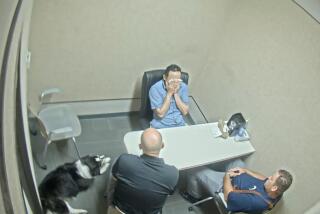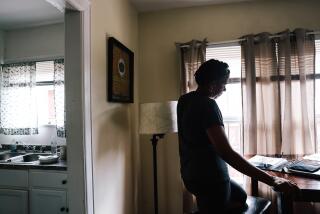Prosecutors Outline Evidence They Say Ties Peyer to Slaying of Knott
- Share via
In statements opening the murder trial of fired California Highway Patrol officer Craig Peyer, prosecutors said Tuesday they will count heavily on blood and fiber evidence that they say prove he killed university student Cara Knott in 1986.
Most of the evidence presented by prosecutors thus far is circumstantial. But Deputy Dist. Atty. Joseph Van Orshoven said that prosecutors have been able to link Peyer to the murder through new fiber evidence recovered from the victim and from Peyer’s gun belt.
According to Van Orshoven’s opening statement, fibers recovered from one of Knott’s hands match fibers from Peyer’s CHP jacket and investigators also found fibers on Peyer’s gun belt that match fibers from the purple sweat suit Knott was wearing on the night she was killed.
Prosecutors said the new set of physical evidence strengthens their case against Peyer, 37. At a preliminary hearing in April, prosecutors called expert witnesses who testified that blood spots lifted from Knott’s boot and sweat shirt matched Peyer’s blood type. Other experts said that a microscopic piece of gold thread found on the woman’s sweat shirt came from Peyer’s CHP jacket patch.
But while Van Orshoven said that physical evidence in the case--albeit circumstantial--will prove that Peyer killed Knott, defense attorney Robert Grimes said in his opening statement that prosecutors have failed to produce “direct evidence that (Peyer) had contact with Cara Knott.”
‘Glaring Errors’
“Not only is there a lot of question as to who killed Cara Knott . . . but when she was killed,” Grimes said. “The evidence will show that Miss Knott wasn’t killed until (Peyer) was back at the station.”
Without elaborating further, Grimes said that Knott was killed by as many as two people. In addition, Grimes said that he will prove that the prosecution’s experts committed “some glaring errors” when they analyzed the fiber evidence used against Peyer.
Peyer, a 13-year CHP veteran, is charged with strangling Knott, 20, a San Diego State University student, on Dec. 27, 1986. Police said she was killed between 9 and 10 p.m. on the old U.S. 395 bridge near Interstate 15 and the Mercy Road off-ramp in San Diego. Knott’s body was thrown 65 feet into a dry creek bed, where it was discovered the next morning.
San Diego Police homicide investigators arrested Peyer on Jan. 15, 1987, after several young women said they had been stopped by Peyer at night for minor traffic violations and forced to park at the same darkened Mercy Road off-ramp.
Jury selection in the sensational case was fast-paced and the momentum continued on the first day of the trial. The opening statements lasted about 15 minutes for each side and after that 15 witnesses were questioned in less than five hours. Knott’s family and boyfriend, Wayne Bautista, testified that she was a cautious and considerate woman who always kept them informed of her whereabouts.
Nervous Vigil
On the night that she was killed, Knott called her family in El Cajon to tell them she was leaving Bautista’s Escondido house and coming home. She stopped at a gas station at 8:27 to purchase gas, and that was the last time she was seen alive. Family members testified that it normally took Knott 45 minutes to make the drive home from Escondido.
When she failed to arrive, worried family members kept a nervous vigil until 10 p.m., trying to work on a jigsaw puzzle, said Sam Knott, Cara Knott’s father. At 10 p.m. a feeling of doom overtook him, he said.
“I got a calling to my soul at about 10 p.m. and jumped out of my chair,” said Sam Knott. Then Knott and his wife began driving along the freeway route that Cara Knott was expected to take, looking for her white Volkswagen.
Sam Knott, Bautista and other family members drove up and down the freeways, checking every exit, for over eight hours, until dawn, searching for Cara Knott’s car. The Mercy Road off-ramp was checked at least twice by Bautista and other family members, but they failed to notice Cara Knott’s car parked in the darkness, behind mounds of dirt and other road barriers leading to the U.S. 395 bridge.
A weeping Sam Knott described the desperate measures, which included looking inside parked and abandoned cars, that he took in searching for his daughter. He told of three futile attempts to convince the CHP and San Diego Sheriff’s deputies to launch a search for his daughter.
Cruiser Spotted
Knott said that early in the search he stopped a CHP cruiser near an El Cajon shopping center and unsuccessfully asked the officer to help him look for Cara Knott. Sam Knott said that he tried again at 1:30 and 3:30 a.m. and stopped sheriff’s deputies to ask them to look for his missing daughter.
But the deputies told him that Cara Knott would have to be missing for 24 hours before a missing person report could be taken, Sam Knott said.
Finally, some time after 6 a.m. on Dec. 28, Knott said he spotted a San Diego Police cruiser near the Mercy Road off-ramp and speeded after him. The police car pulled into the off-ramp, where Sam Knott said his daughter Cynthia and her husband, William Weick, were standing.
“I saw my daughter’s (Cara) car parked there,” said Sam Knott.
The couple had found the car parked at the bottom of the off-ramp, near the old U.S. 395 bridge. They called the police and family to tell them of their find.
Weick testified that he and his wife called out Cara Knott’s name repeatedly, not knowing that she was laying in the creek bed below the bridge.
‘Foggy, Dark and Creepy’
“It was foggy, and dark and creepy,” Weick said. “. . . There was this bridge, something out of a movie . . . I didn’t know what was down there at all.”
Jean Pierre Gulli and his twin brother, Robert, testified that they were stopped by Peyer at about 10 p.m. on the night that Knott was killed. The brothers were pulled over by Peyer near Balboa Avenue and California 163 for having defective taillights on their vehicle.
Jean Pierre Gulli testified that Peyer scratched out the correct time that he had written on the citation and wrote an incorrect time. Van Orshoven said later that Peyer wrote 9:20 p.m. on the ticket, which is close to the time that police said Knott died.
CHP Officer Joseph Riordan testified that at 10:30 p.m. when he saw Peyer at the end of the shift, Peyer’s uniform appeared “disheveled.”
“His dress was a little disheveled. His jacket was a little cockeyed . . . I noticed some blood about his forehead and on one of his hands,” Riordan said.
Peyer ‘Seemed Nervous’
Shirley Schwartz, an attendant at a gas station on Kearny Villa Road, testified that Peyer pulled in at about 9:30 p.m. on the night of the murder to buy gas for his CHP cruiser. According to Schwartz, Peyer “seemed nervous, disheveled and had scratches on his face.”
The woman said she noticed three scratch marks on the right side of Peyer’s nose. When asked how he was doing, Schwartz said Peyer answered that “it had been a rough night.”
The alleged scratch marks have surfaced as a controversial issue in the case. Although Schwartz said she noticed the scratch marks, an off-duty San Diego Police officer who was at the station while Peyer was buying gas testified at the preliminary hearing that he had a close look at Peyer’s face but did not see scratch marks.
Four people who were stopped by Peyer after Knott was killed have also testified that they did not see any scratch marks on Peyer’s face when he stopped their cars. Riordan also said that he did not notice the scratch marks on Peyer’s face at the end of the shift.
Some CHP officers testified at the preliminary hearing that Peyer told them he fell while filling up his cruiser at the CHP station at the end of his shift. The officers said that Peyer told them he slipped and brushed his face against a chain link fence, scratching his face.
Joyce Knott, Cara Knott’s mother, testified Tuesday that they took a self-defense course together and were trained to claw at an attacker’s face and eyes.
More to Read
Sign up for Essential California
The most important California stories and recommendations in your inbox every morning.
You may occasionally receive promotional content from the Los Angeles Times.













